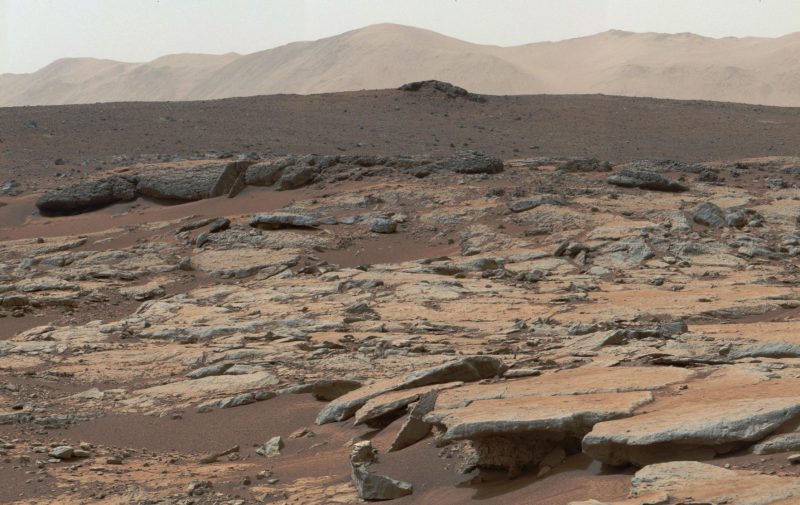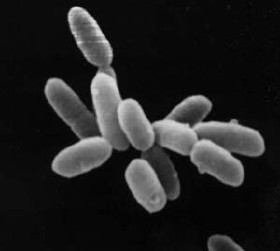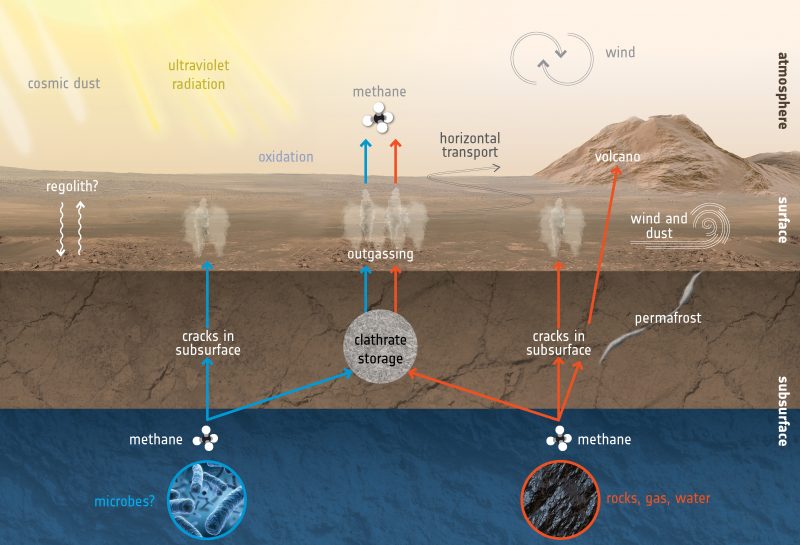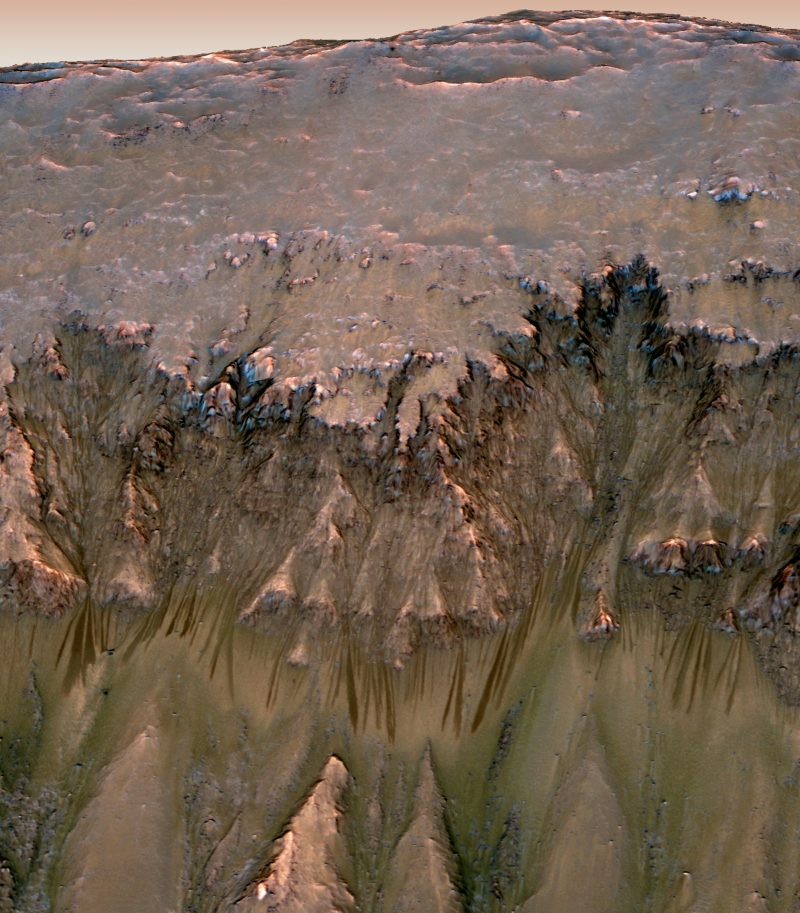
Since it was first detected earlier in this century, methane in Mars’ thin air has been one of the most intriguing mysteries of the red planet. Record high levels of methane – reported in Mars’ atmosphere last June – was one of 2019’s biggest science stories. Is Mars’ methane created by geological processes? Or could it be a sign of life? That debate has raged more intensely in the past few years. Now a new study by researchers at Technical University Berlin (TU Berlin) outlines a possible mechanism where microbial life could indeed explain the findings.
The research was discussed in an article by Dirk Schulze-Makuch in Air & Space on January 9, 2020, and the peer-reviewed paper was published on January 8 in Scientific Reports. The findings were also presented on September 4, 2019, at the 19th EANA Astrobiology Conference in Orleans, France.
The study, led by Debbie Maus from TU Berlin, focused on how microbes can survive on water obtained only through deliquescence, where salts absorb tiny amounts of water directly from the air and then dissolve in the absorbed moisture. This would be essential on Mars, where there is no liquid water known on the dry, cold surface. Extremophile microorganisms on Earth can survive this way, however, making use of whatever tiny amounts of moisture are present. Could the same be true for Mars?
Some earthly microbes that employ deliquescence also release methane. And it’s known that Martian soil contains salts. So could deliquescence on Mars explain the methane in the air? While the current study doesn’t prove it does, the study does suggest that this explanation is plausible.
The 2020 lunar calendars are nearly sold out! Order yours before they’re gone. Makes a great gift!

How did Maus and her team reach these conclusions?
They used three different versions of simulated Martian soil, including the salts. These were contained in a special chamber that recreated conditions on the Martian surface. The researchers wanted to see if certain types of microbes would use the salts to obtain moisture through deliquescence in these simulated hostile conditions with very thin atmosphere, bitter cold and no liquid water.
The researchers tested three types of methanogenic archaea (methanogens), single-celled microorganisms similar to bacteria that, on Earth, live in environments with very low oxygen levels, much like Mars. All three types produce methane as a by-product of their metabolism.
Two out of the three types of microbes did produce methane in the simulated Martian conditions. Noteworthy is that this was particularly true when the tests used salts and soils similar to those found in ancient lakebeds on Mars, which have high clay content. This is just the kind of terrain that the Curiosity rover is in right now in Gale Crater – which used to be a lake or series of lakes a few billion years ago – and Curiosity has confirmed methane on more than one occasion now. Curiosity is currently examining clay-rich soil on the lower slopes of Mount Sharp in the middle of the crater.
The new study provides a plausible mechanism for the release of methane into the Martian atmosphere, although it still isn’t known for sure whether the methane is the result of biology or geology. On Earth, the vast majority of methane is produced by organisms, and the same could be true for Mars as well, but that is by no means certain at this point.

The researchers found that even if the microbes were desiccated – dried out – and dormant, they could be revived by deliquescence and release methane. From the paper:
Our results show, for the first time, that rehydration of MRAs [Martian regolith analogs] through deliquescence can reactivate the metabolism of desiccated methanogenic archaea. The design of the CDS provided deliquescence-driven water transport into the incubation chamber, but only when a hygroscopic salt was present. Our data also showed that methane production depends greatly on the methanogenic species, the incubation temperature, and the type of MRA and salt used in the experiments.
With the custom-designed Closed Deliquescence System (CDS), we have simulated the in vitro process of deliquescence and demonstrated that Methanosarcina soligelidi and Methanosarcina barkeri can survive desiccation in the presence of 30 wt% sodium chloride in a phyllosilicate-containing Martian Regolith Analog, and furthermore become metabolically active after water is provided by deliquescence.
Thus, we conclude that methanogenic archaea can live in environments with transient water availability and cope with varying salt concentrations. Consequently, salt-rich near subsurface environments on Mars subject to periodic wetting, such as proposed for RSLs [recurring slope lineae], can be considered potential habitats for certain halotolerant methanogenic archaea and could potentially be a biological source of methane in the Martian atmosphere.
The RSLs or recurring slope lineae are another feature on Mars that contain hydrated salts. These dark streaks on steep slopes may be the result of brief flows of briny water, but there is still much debate as to their actual cause. If there is moisture involved, they may be ideal locations for such salt-loving microbes to exist. There are even some RSLs on Mount Sharp in the middle of Gale Crater. The Curiosity rover could drive closer, but its controllers at NASA decided against it; there was a risk of contamination by the rover, which could still have some stray earthly microbes of its own on board.

Curiosity found evidence that the methane, at least near its location, is seasonal in its variation. That could be the result perhaps of clathrate ices or soils periodically releasing some trapped methane during warmer periods, other geological processes, or even a function of biology.
In a previous study, scientists found that the methane detected by Curiosity exhibits daily variations as well as seasonal ones. As John Moores at York University in Canada explained:
This most recent work suggests that the methane concentration changes over the course of each day. We were able – for the first time – to calculate a single number for the rate of seepage of methane at Gale Crater on Mars that is equivalent to an average of 2.8 kg [.7 gallons] per Martian day.
Another previous study also showed that wind erosion of rocks was unlikely to account for the variations in methane seen by Curiosity.
Methane was first found in the Martian atmosphere in 1999 by ground-based telescopes. The origin, however, is still a mystery despite the gas also being detected many times since then with various orbiters and the Curiosity rover. Curiosity also recently detected unusual seasonal variations in the amount of oxygen in Gale Crater, but further testing is needed to determine if there is any connection to the methane variations.

So far, the search for life on Mars – past or present – has focused on the follow the water scenario. But if this new research is any indication, and as noted at the EANA Astrobiology Conference, maybe it’s time to modify that approach:
While our results emphasize the importance of the substrate, archaeal species, salt, and temperature used, we show – more importantly – for the first time that water provided through deliquescence alone is sufficient to rehydrate methanogenic archaea and to reactivate their metabolism under conditions roughly analogous to the near-subsurface Martian environment.
Thus, we suggest that a more important mantra for the search of life on Mars is ‘follow the salt’ rather than ‘follow the water.’ Future space missions, including life detection missions, should explore salt-rich regions on Mars as prime targets for astrobiology.
Bottom line: New laboratory studies from researchers at Technical University Berlin suggest that microbes similar to methanogenic archaea on Earth could be producing Mars’ mysterious methane.
Source: Methanogenic Archaea Can Produce Methane in Deliquescence-Driven Mars Analog Environments
Source: The Process of Deliquescence Might Allow Methanogenic Archaea to Metabolize on Mars











